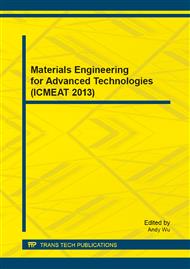p.260
p.265
p.271
p.278
p.283
p.288
p.293
p.297
p.302
Changes of Load Distribution on Cup-Bone Interface at the Different Positions of Non-Cemented Acetabular Cup
Abstract:
Objective To explore the relationship between acetabular cup position and the load distribution within the acetabulum and to confirm an optimal range of cup position, thereby providing a theoretical criterion from a biomechanical aspect for proper cup implantation in clinical work. Methods A male adult cadaveric pelvic was scanned with spiral CT, and then the two-dimensional images were evaluated using GE medical systems software and the outline of the pelvis was identified by the edge detective estimation. Pelvic coordinate data were put into the computer to build up a three-dimensional (3D) finite element model of the pelvic using Solidworks software . A φ48 non-cemented cup from Tianjin Huabei Medical Instrument Factory was used, and the 3D measurement of the cup was carried out by CLY single-arm 3D measurement apparatus, which was made in Testing Technology Institute of China. The measurement data were transferred into computer. Through the CAD Sliod Works 2010 software, the 3D model of the cup was automatically reconstructed. After wards, one-foot standing position was simulated to conduct the loading and constraint of the model, the Mises and shear force distributing of the cup were analyzed, forecasting the mechanical risk of prosthetic failure. Results In the 3D finite element model of human pelvis, the number of total nodes was 103043 and the number of total elements was 69271. Abduction angle did not affect the Mises and shear force distributions between the range of 40°-50°(P>0.05). However, significant affects appeared in Mises and shear force once the abduction angle was < 35° or > 50°. The change of the cup anteversion within5°-30°would not affect the Mises and shear forces in the acetabulum (P > 0.05). Conclusion A uniform load distribution on the cup-bone interface can be obtained when the cup abduction angle is from 40°to 50°. The change of the cup anteversion angle can not affect the load distribution in the acetabulum, therefore the cup abduction range of 40°-50°can be confirmed as the safe range for cup implantation.
Info:
Periodical:
Pages:
297-301
Citation:
Online since:
February 2014
Authors:
Price:
Сopyright:
© 2014 Trans Tech Publications Ltd. All Rights Reserved
Share:
Citation:


